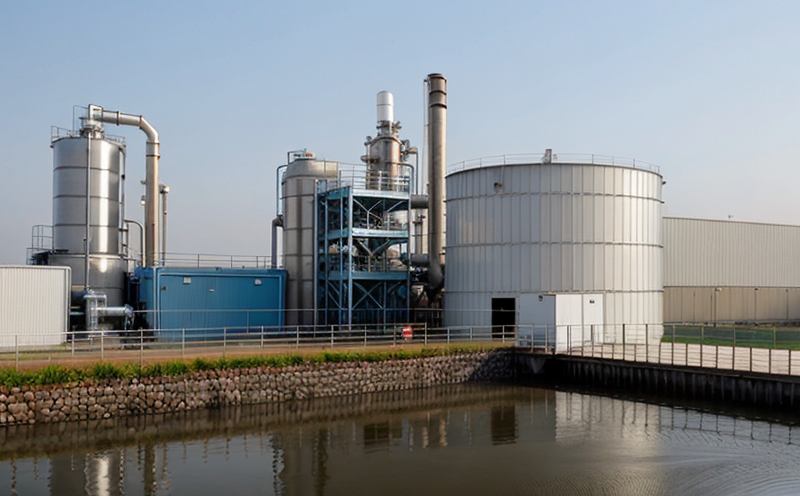DIN 38411 Phosphorus Testing in Wastewater Samples
The DIN 38411 standard is a critical tool used by industrial facilities to ensure compliance with environmental regulations and maintain water quality standards. This standard provides stringent guidelines for the determination of total phosphorus (TP) in wastewater samples, which is essential for preventing eutrophication and maintaining ecological balance in receiving waters.
Phosphorus is one of the primary nutrients that can lead to excessive growth of algae and other aquatic plants, causing harm to water ecosystems. DIN 38411 specifies a colorimetric method that allows for accurate measurement of total phosphorus levels. The standard ensures precision and consistency in testing by outlining detailed procedures for sample preparation, reagent addition, and the reading of absorbance at specific wavelengths.
The importance of this test cannot be overstated, especially for industries such as food processing, chemical manufacturing, and textile production, where wastewater discharges can have significant environmental impacts. By adhering to DIN 38411 standards, these facilities not only comply with legal requirements but also contribute to the preservation of natural water bodies.
The testing process involves a series of steps that begin with proper sample collection. Samples must be collected from designated points in the facility’s wastewater treatment system and stored under controlled conditions to prevent any changes in phosphorus content. Once collected, the samples are analyzed using the colorimetric method outlined in DIN 38411.
The colorimetric test involves adding a reagent that reacts specifically with orthophosphate ions present in the sample. The reaction results in a colored complex whose intensity is directly proportional to the amount of phosphorus present. This complex is then measured using a spectrophotometer, which reads the absorbance at 670 nm.
The results from this test are crucial for quality managers and compliance officers as they provide quantitative data that can be used to evaluate the effectiveness of wastewater treatment processes. The data helps in identifying areas where improvements may be needed to reduce phosphorus discharge into the environment.
In addition to its regulatory importance, DIN 38411 testing also offers significant benefits for R&D engineers and procurement teams within industrial facilities. For R&D teams, this test can provide insights into the efficiency of new wastewater treatment technologies. Procurement officers can use these results to evaluate suppliers of water treatment chemicals and equipment.
The accuracy of DIN 38411 testing is paramount. Factors such as proper sample handling, adherence to temperature control during analysis, and consistent calibration of instruments are critical for obtaining reliable results. Facilities that invest in high-quality instrumentation and trained personnel can ensure the precision required by this standard.
In summary, DIN 38411 phosphorus testing plays a vital role in maintaining environmental compliance and water quality standards within industrial facilities. The detailed procedures outlined in this standard provide a robust framework for accurately measuring total phosphorus levels, ensuring that discharges meet regulatory requirements and protect aquatic ecosystems.
Applied Standards
| Standard Number | Description |
|---|---|
| DIN 38411-5 | Method for the determination of total phosphorus in water by colorimetric method (phosphomolybdic-phosphotungstic acid complex) |
| DIN 38411-6 | Method for the determination of organic phosphorus and total phosphorus in water by spectrophotometric method after digestion with nitric acid |
The DIN standards provide a comprehensive approach to testing phosphorus levels in wastewater. These methods are widely recognized and used globally, ensuring consistency and reliability across different facilities.
Customer Impact and Satisfaction
By implementing DIN 38411 phosphorus testing, industrial facilities can significantly impact customer satisfaction and environmental compliance. Customers expect products to be made using environmentally responsible practices, and demonstrating adherence to standards like DIN ensures that these expectations are met.
In addition, the data generated from this testing helps in building trust with regulatory bodies, which is crucial for maintaining a good reputation and avoiding penalties. The precision of the test results also allows facilities to optimize their wastewater treatment processes, leading to cost savings and operational efficiency.
For procurement teams, compliance with DIN standards ensures that they are selecting suppliers who adhere to high environmental standards. This not only supports the facility’s sustainability goals but also enhances its overall reputation in the market.
Competitive Advantage and Market Impact
DIN 38411 phosphorus testing provides a competitive edge by ensuring that industrial facilities operate within strict environmental regulations. This not only minimizes risks of legal penalties but also enhances the facility’s reputation as an environmentally responsible entity.
The precision and reliability of DIN test results can differentiate a facility from its competitors, especially in sectors where environmental compliance is a key factor for customers. For instance, food processing facilities that comply with DIN standards can market their products as environmentally friendly, attracting a broader customer base.
Moreover, the data generated from DIN testing can be used to benchmark performance internally and against industry peers. This allows facilities to identify areas for improvement and innovate in wastewater treatment technologies, further enhancing their competitive position.





